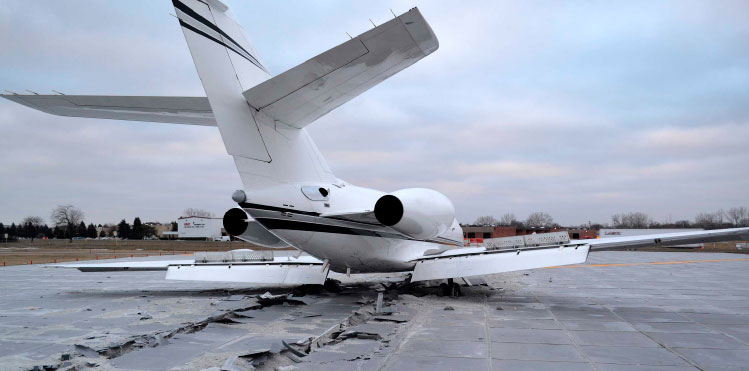
Zodiac Aerospace has marked its 10th successful aircraft save after it safely stopped an overrunning Falcon 20 aircraft on the departure end of Chicago Executive Airport’s main runway. “What is so special about this particular save is that it involved a lighter weight aircraft, which proves the effectiveness of our product in safely stopping a range of aircraft,” says Kevin Quan, Vice President, Sales & Marketing, Zodiac Aerospace. Photo courtesy of Chicago Executive Airport
Kevin Quan, Vice President, Sales & Marketing, Zodiac Arresting Systems America, interviewed by Marta Dimitrova.
On 26 January 2016, an aircraft, operating as a medical cargo plane, departed from Willow Run Airport in Detroit. At 04:05, when landing, the Falcon 20 overran Chicago Executive Airport’s main runway, RW16, nearly entering a four-lane highway, before it was safely stopped by one of the airport’s two EMASMAX® Engineered Material Arresting Systems (EMAS). There were no injuries to the Falcon 20 pilot and co-pilot and only minimal damage to the aircraft. What is more, after the aircraft was extracted from the EMASMAX bed, the runway was reopened for use that same afternoon.
This successful save at Chicago Executive Airport not only proved the reliability of EMASMAX, which had previously saved nine aircraft at commercial airports during real emergency overrun situations, but also marked its landmark 10th successful aircraft save, proving the effectiveness of the product in safely stopping a range of aircraft.
“We were ecstatic to see another EMASMAX bed perform as predicted and successfully saving lives as it has been designed to do,” explains Kevin Quan, Vice President, Sales & Marketing, Zodiac Arresting Systems America (ZASA), a subsidiary of Zodiac Aerospace. “Our product has a perfect record of stopping 10 out of 10 aircraft with minimal aircraft damage and little to no injuries to passengers.”
First introduced back in 1996, the product’s predictable performance and reliability has resulted in a perfect safety record that has saved 245 lives and gained the trust of airports worldwide.
Today, ZASA has nearly 115 EMASMAX installations at 66 airports worldwide and the product continues to gain acceptance as more and more airports see the value of this safety technology. “We are in discussions with a number of airports in several continents and there has been an increase in the number of requests from airports and consultants to evaluate the benefits of the EMASMAX solution,” Quan comments.
So, how does it work? An EMASMAX arresting system consists of a bed of engineered, low-strength cellular cement blocks that can be placed at the end of a runway to stop overrunning aircraft in emergency situations. Each EMASMAX arrestor bed is specially designed to stop the given fleet mix that operates on that runway. The arrestor bed will reliably crush under the weight of an overrunning aircraft with minimal aircraft damage and little to no injuries to passengers. This has been the case in all 10 EMASMAX aircraft saves to date.
But what makes EMASMAX so unique compared to the traditional runway safety area is that it requires far less space than having to acquire land and build out or give up runway space to get the required runway safety area (RESA) length. “This benefit may come in the form of cost savings for the airport or allow a space-constrained airport to benefit operationally by increasing runway length through reduction of standard RESA when an EMASMAX is installed,” Quan says.
Meanwhile, ZASA is also in the early stages of research and development of new products, which, Quan explains, will again be focused on airport safety and are based largely on feedback from airports on the challenges that they face today. These include: an electronic inspection tool for the EMASMAX arrestor beds, RCAM (Runway Condition Assessment Matrix) training, and airport mapping technology, all developed by implementing partnerships with aviation industry experts.
10 out of 10 aircraft saves is, indeed, an impressive achievement, and ZASA is already looking ahead.
“We plan on continuing our introduction of the benefits of EMASMAX technology to more and more countries. We also would like to broaden our product offering of airport safety solutions to our customers,” Quan concludes.







